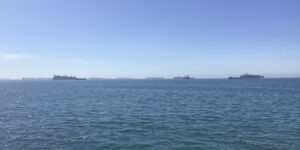
You might want to start your Christmas shopping early.
That’s the big takeaway from the ongoing situation at major seaports on the West Coast right now, particularly at Los Angeles-Long Beach, the biggest and busiest port complex in North America.
According to reports, shipping traffic is up 50% from pre-pandemic levels, contributing to the bottleneck. Another contributing factor is a shortage of drivers to haul goods away from port terminals, as well as a shortage of trailers to affix containers to and of storage space at terminals.
“The American’s buying strength is so strong and epic, that we can’t absorb all this cargo into the domestic supply chain,” Port of LA Executive Director Gene Seroka recently said regarding the situation.
Together, LA and Long Beach handle about 40% of goods imported into the U.S., data show. And with this being the peak shipping season, which runs from August through October, it’s possible that consumer goods arriving from Asia might be stuck on the docks for several days at a time before making it to a warehouse and/or to a retail outlet.
In an article on page 24 of the upcoming issue of Pacific Maritime by veteran transportation reporter Ripley Watson, it’s said that in July, dwell time for containers leaving San Pedro Bay ports by truck was 5.2 days, which is 88% higher than the same month in 2020. If you think that’s bad, the article also states that according to Port of LA data, the process of moving cargo off dock by rail during the same period reached 13 days, nearly two full weeks.
All this means that consumers may not be able to find the items they want or receive them when they want, particularly holiday shoppers, because so many goods are tied up on the docks or still waiting in line to enter a port terminal.
In fact, about a three-minute drive from where I live sits a massive queue of dozens of ships just offshore waiting to enter the Port of Long Beach. (See the accompanying photo.)
I’m not going to point fingers at one aspect of the supply chain or another when it comes to the situation at hand, but I will say that there’s plenty of blame to go around. All involved in the business of transporting containerized goods – shippers, 3PLs, longshore workers, drayage companies, railroads, etc. – need to work together to figure out solutions to bottleneck issues so that the floating parking lots currently outside some of the West Coast’s busiest ports don’t become a permanent feature of the landscape.
Managing Editor Mark Nero can be reached at mark@maritimepublishing.com

